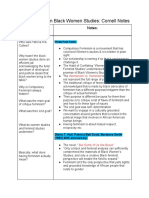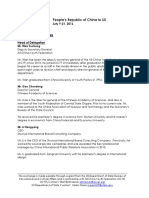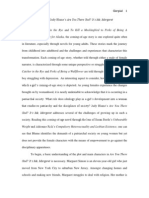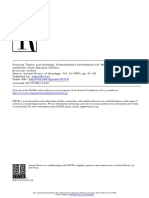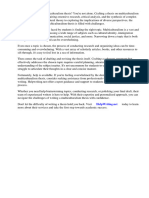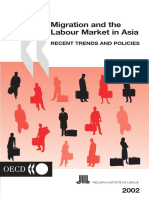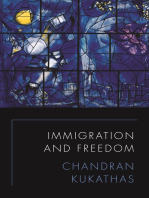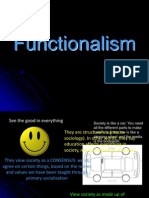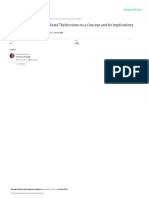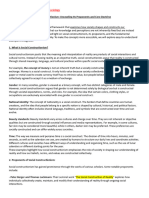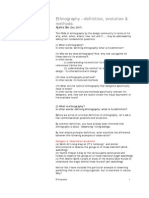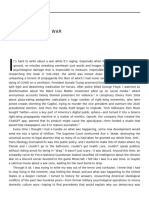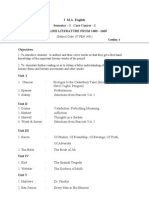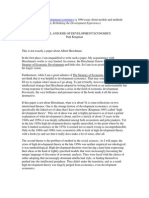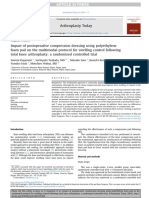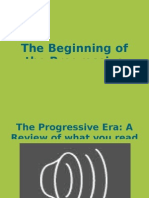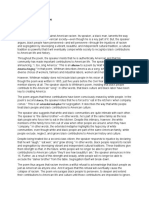Toward Multiculturalism
Toward Multiculturalism
Uploaded by
Cristina SavaCopyright:
Available Formats
Toward Multiculturalism
Toward Multiculturalism
Uploaded by
Cristina SavaCopyright
Available Formats
Share this document
Did you find this document useful?
Is this content inappropriate?
Copyright:
Available Formats
Toward Multiculturalism
Toward Multiculturalism
Uploaded by
Cristina SavaCopyright:
Available Formats
International Journal of Intercultural Relations 37 (2013) 657662
Contents lists available at ScienceDirect
International Journal of Intercultural Relations
journal homepage: www.elsevier.com/locate/ijintrel
Whither multiculturalism? Global identities at a cross-roads
Chan-Hoong Leong a, , James H. Liu b
a
b
National University of Singapore, Singapore
Victoria University of Wellington, New Zealand
a r t i c l e
Keywords:
Immigration
Acculturation
Intergroup relations
Identity
Multiculturalism
Adaptation
Integration
Interaction
Status
Identication
Dominance
i n f o
a b s t r a c t
Technological advancement and the quantum leap in global trade had enabled many
countries to enter an era of multiculturalism where intergroup contact with members of
another ethno-cultural community is the norm rather than the exception. While this phase
of economic development is considered progressive by many, it is also regarded as a perilous stage in nation building. Immigration, acculturation, and intergroup tensions will form
the nexus of all future contestations with the various social groups negotiating with and/or
vying against one another for political rights and status. At the same time, the notion of culture has become increasingly blurred given the multiplicity and interwoven nature of social
identity arising from the transnational human movement and the transmission of values.
With these considerations in mind, this chapter explores and extrapolates the emerging
fabric of multiculturalism across various continents using a historical, socio-political, and
psychological lens. Contemporary acculturation and intergroup frameworks are re-visited
with the aim to discover new theoretical insights, while keeping in mind the possible trajectory of multiculturalism and how diversity will be managed in the decades to come.
2013 Elsevier Ltd. All rights reserved.
1. Introduction
The culture and population composite of people living in Asia, Latin America, Africa, Canada and the Oceanic have undergone tremendous changes over the last two decades. The tectonic shift in demography has been driven largely by the
transnational movement of immigrants, refugees, expatriates and international students, and amplied by the growing
complexity and interwoven nature of the global economies. This is complemented by the fact that most states have never
been homogeneous culturally or ethnically: it is nation-building policies that have obscured or erased cultural differences in
their long-term resident populations (Hobsbawm, 1990; Nora, 1989). As globalization becomes ever more pervasive (Ritzer,
2011), the ability of states to suppress or erase cultural differences is going to continue to be compromised (Arnett, 2002). At
the same time, majority groups within states seem to have a persistent yearning for simpler times for their communities
that may well be imagined (Anderson, 1991). The idea of multiculturalism encompasses demographics, ideology, and policies with respect to cultural diversity (Berry, Kalin, & Taylor, 1977) and as such is a key concept for revisiting as we venture
further into a globalizing age.
Statistically, the total number of international immigrants today stands at 214 million, up from an estimated 150 million
ten years ago (United Nations Department of Economic and Social Affairs (UN DESA), http://esa.un.org/). There are currently
15.4 million asylum seekers around the globe, with one in every 33 persons in the world being born outside their state
of settlement. The ebbs and ows of migration are not conned to those seeking permanent settlement, as the data on
Corresponding author. Tel.: +65 6516 5601.
E-mail addresses: leong.chanhoong@nus.edu.sg, chanhoong@email.com (C.-H. Leong).
0147-1767/$ see front matter 2013 Elsevier Ltd. All rights reserved.
http://dx.doi.org/10.1016/j.ijintrel.2013.09.004
658
C.-H. Leong, J.H. Liu / International Journal of Intercultural Relations 37 (2013) 657662
international students shows. Enrolment records in universities have witnessed an exponential increase in recent decades on
the number of international and exchange students (World Education Services, http://www.wes.org/). Like the immigrants
and refugees, these sojourners are the interlocutors of cross-cultural processes that are hallmarks of this age of late capitalism
(Ritzer, 2011). Not unexpectedly, the rising ux of human mobility is closely tied to the volume of remittance transferred;
in 2000, USD132 billion was transferred from one continent to another; by 2010, the amount almost quadrupled to USD440
billion (UN DESA, http://esa.un.org/).
The dynamics of cross-cultural interactions will shape future intergroup relations, cohesion, and harmony in a profound
way. Increased cultural heterogeneity and contact is not always accompanied by a parallel rise in social acceptance. Neither
is there evidence to suggest a movement towards the formation of a singular global identity (Arnett, 2002). Wars in the
Gulf States, the ght against terrorism, and the global nancial meltdown in recent times have all inuenced multicultural
attitudes in a less than benign direction. Shifts in public opinion are further compounded by pan-cultural challenges in
how multiculturalism is constructed, as the notion of multiculturalism is sometimes calibrated differently depending on the
social context (e.g., voluntary vs. involuntary transition) and the type of ethno-cultural groups in examination (e.g., local
born vs. immigrants). Societal norms and values regulating intercultural engagement are constantly evolving with some
nation-states outperforming others in the management of cultural diversity (Banting & Kymlicka, 2006). It is for this reason
that the special issue is dedicated to exploring the socio-psychological processes and outcome of cultural plurality in the
new multicultural milieu.
The special issue comprises eight papers, including the current chapter. It offers an audit on the state of multiculturalism
among selected countries in North America (Canada), Southeast Asia (Malaysia, Singapore), Africa (Mauritius), Latin America
(Chile, Peru), and the Oceania (New Zealand). Several theoretical frameworks and assumptions on intercultural transition,
acculturation, and multicultural relations are revisited, some of which are re-examined through the refreshing lens of new
theory and new empirical data. One article offers a thematic analysis of all multicultural-linked publications in the journals 35
years of history, with an aim to consolidate, synthesize and illuminate prospective strategic directions for future multicultural
research.
Readers may wish to refer to a parallel special issue on multiculturalism edited by John Berry and David Sam for The
European Psychologist (EP). The EP Special Issue contains ve papers that address various psychological aspects of living in
a number of multicultural societies in Europe. Two of the papers focus on general features of the acculturation process and
the psychological and sociocultural adaptations that result. One examines these processes and outcomes among immigrant
youth in Germany (see Frankenberg, Kupper, Wagner & Bongard) while the other reports on research with internal adult
migrants in Russia (see Lebedeva & Tatarko). The other three papers each have a more specic focus on social institutions:
education, sport and religion. The role of multicultural education in promoting positive inter-ethnic attitudes is discussed
by Verkuyten and Thijs. The role of sport in fostering intergroup harmony is examined by Hatzigeorgiadis, Morela, Elbe,
Kouli, and Sanchez. Finally, the core issue of religion in multicultural Europe is considered by Gngr, Fleischmann, Phalet
and Maliepaard.
2. Multiculturalism as a social construct
Multiculturalism has been enunciated in multiple ways depending on the context. A comprehensive denition by Berry
et al. (1977) identied three levels at which the concept can be dened demography, ideology, and policy. At the demographic level, a multicultural society is represented by distinct ethno-cultural groups living together in a given geography.
At the ideological level, multiculturalism is conceptualized within the prevalent political and religious ethos, which may
include injunctions on the degree of tolerance and mutual respect, and allowance for ethno-cultural groups to maintain their
heritage culture that is normative. Needless to say, cultural diversity does not equate to ideological pluralism; nor does the
presence of different racial and religious groups imply harmonious co-existence. At the policy level, government legislation
and enforcement exemplify how diversity is managed politically, and the kinds of intergroup climates these give rise to.
The provision for equitable resource access rights, reduction of discrimination, and the removal of barriers to participate
across the full spectrum of socio-economic activities form the nexus of policy inclusion. The three levels overlap, although
one could argue that the inclusiveness of social policies constitute the apex of multiculturalism.
While some critics have argued that recent ethnic tensions in Europe have proved that multiculturalism is a failure,
proponents of cultural plurality assert that too much attention has been given to diversity without considering issues of
equitable participation, such as the need to promote social inclusion and forging a common in-group identity (Berry, Chapter
3). In short, there is often demographic diversity, and also often not enough public or political support for managing its
dividends.
3. Multiculturalism as a research framework
Berry (in this issue) argues that a comprehensive multiculturalism research framework should consider three theoretical
perspectives. First, the multicultural hypothesis asserts that the degree of condence in an individuals socio-economic status
is a pillar to cross-cultural sharing, mutual respect, and acceptance of other ethno-cultural group members. Second, the
integration hypothesis postulates that a concurrent engagement with both heritage and dominant cultures is considered the
C.-H. Leong, J.H. Liu / International Journal of Intercultural Relations 37 (2013) 657662
659
most adaptive strategy to maintain or enhance personal socio-psychological wellbeing. Third, intergroup contact promotes
positive intercultural relations when the processes take place in an equitable, intimate, and non-threatening environment.
This analytical framework recognizes the multifaceted and overlapping nature of cultural plurality; ethno-cultural
continuity and intergroup contact reinforce one another while offering a parsimonious platform for multicultural and
acculturation studies across socio-cultural settings. With this in mind, the rst chapter by Berry provides a comprehensive
overview on the key theoretical concepts, and the ndings from more than 30 years of empirical research in Canada.
The multiplicity and non-exclusion of cultural identity is corroborated in the thematic analysis by Arasaratnam (chapter
2, in this issue). Drawing from 35 years of IJIRs publications on multiculturalism, the ndings from Arasaratnams analysis
offers a solid testament that the theoretical issues examined here are of enduring interest. Four major themes are identied in her paper, each providing a unique lens to distill multiculturalism research: multicultural education, attitudes to
multiculturalism, multicultural interactions, and multicultural identity.
Research on multicultural education showcases how social norms and education priority have changed over the years.
Cross-cultural training has, in last three decades, shifted from steering minority ethnic groups towards mainstream culture
assimilation to creating the impetus for cultural awareness and experiential learning; this theme exemplies the transformation of multiculturalism at the policy level. Studies on multicultural attitudes explain the formation and changes in
ideological perspectives towards diversity management. The theme mirrors the effect and outcome of the multicultural
hypothesis (Berry & Kalin, 1995), where socio-economic condence precipitates intercultural sharing, mutual tolerance
and acceptance towards diversity. Research on multicultural interaction describes how intergroup divides can be bridged
by encouraging outgroup contact and exposure, and consequently dispels negative outgroup stereotypes through cultural
familiarity; this theme echoes the theoretical propositions derived from the contact hypothesis. Finally, research in multicultural identity focuses on both the enduring traits that predispose the individual to behaving or thinking in certain ways,
and new formulations of identity adapted to various socio-cultural contexts.
While these existing analytical frameworks have provided a holistic platform for multicultural and acculturation research,
there is a call to look beyond the current theoretical paradigms in view of the growing inadequacy of linking multiculturalism
to a single mainstream society or to a single acculturating minority (see also Benet-Martinez, 2012; Ward, 2008). Social
identities can no longer be easily demarcated into the neat, bicultural Berry boxes framework without considering the
multifaceted and overlapping nature of contemporary acculturation experiences. The new-age sojourner and migrant are
likely to hold multiple cultures; they are often the offspring of inter-ethnic marriages, brought up in a third culture, received
their education in Euro-American universities, are employed by multinational corporations and work in an emerging market
in Asia. Locating the appropriate culture(s) as an anchor becomes a problematic exercise. The challenge is further exacerbated
by the contextual assessment of acculturation as individuals gravitate to different cultural orientations depending on the
environment and the type of activities. For instance, they may show a preference for heritage cuisines at home but prefer
local delights in the workplace.
The term hyper diversity was coined by Doucerain, Dere and Ryder (Chapter 4) to illustrate these emerging conceptual conundrums. Doucerain and associates propose a Cultural Day Reconstruction Method (C-DRM) for multiculturalism
research. Rather than seeking a generalized, and often dichotomous, view of acculturation, the C-DRM dissects behaviours
and day-to-day activities in bite sizes to determine the individuals orientation to heritage, mainstream, and hybrid cultures
in different situations. Their innovative adaptation of Kahneman, Krueger, Schkade, Schwarz, and Stone (2004) research
method of studying daily life experiences offers a refreshing lens to reveal the overlapping layers of identities and their
profound inuences of the experience and conception of cultural diversity.
Taken in concert, these three articles provide an overarching view of both the established theories and methodological and
conceptual challenges moving forward. Traditional models may need to be adjusted to meet the evolving, hyper diversity
textures of the future to stay relevant. Doucerain et al. and Arasaratnams chapters provided a glimpse to the future of
multicultural research, while being thoroughly anchored in the substantial progress reported by Berry.
4. Contextualizing multiculturalism
Multiculturalism is neither a monolithic construct nor a linear function of individual ideologies. The inuence of intercultural contact on social plurality is rarely independent of its socio-political environment even though the analytical
frameworks are similar across continents. In reality, both personality and situational context jointly inuence contact outcome (Esses & Jackson, 2008). The chapters by Sibley and Ward (Chapter 5) and Noor and Leong (Chapter 6) offered in-depth,
critical analyses on how the historical context may inuence the functioning of multicultural ideology in pluralistic societies.
Data from the 2009 New Zealand Attitudes and Values Survey (NZAVS-09) shows that most New Zealanders have a positive
regard to multiculturalism, expectation of race-based rejection was uncommon, intergroup relations were mainly warm,
with low perceived threats, moderate future security, and a strong sense of patriotism. Deeper probes into the NZAVS-09
however reveal a complex picture on the state of intercultural relations; while there is support to diversity as a political
ideology, the reaction to the resource implications of multiculturalism were lukewarm, with the majority rejecting any form
of race-based interventions to reduce social inequality. This echoes similar ndings reported by Berry in Canada. Intergroup
attitudes differed sharply along ethnic lines, with Asian immigrants reporting greater prejudice than other ethnic communities, and the indigenous Maori feeling the least secure and most threatened by the inux of recent Asian migrants.
The parallels between the New Zealand case illustrated by Sibley and Ward and the Canadian case presented by Berry are
660
C.-H. Leong, J.H. Liu / International Journal of Intercultural Relations 37 (2013) 657662
manifestly obvious, with the role of the threatened long-term group in Canada played by French speakers (especially in
Quebec).
The sense of vulnerability among Maori is largely explained within the context of past social injustice and current disadvantages in status on the socio-economic ladder (see Sibley, Liu, Duckitt, & Khan, 2008). There is a hierarchy of preference
for immigrants ethno-cultural status and the observed stereotypes against Asian New Zealanders are consistent with the
empirical literature that shows a distinct preference for immigrants from Anglo-Saxon origins over those that hail from Asia
and the Middle East (e.g., Dandy & Pe-pua, 2010; Ward & Masgoret, 2008).
The paper by Noor and Leong echoes the inuence of contextual effects in multicultural research in Singapore and
Malaysia. Both countries are former colonies of Britain and for many years, the nexus of cultural diversity has been centred
on racial identity and race relations between the ethnic Chinese, Indian, and indigenous Malay communities. The paper
offers a comparative analysis on how the two Southeast Asian countries manage cultural plurality, the historical trajectory
of race-based politics, and the emergence of new social ssures confronting both nations. While both these Southeast Asian
countries recognize the signicance of race as a social identity, the philosophy embraced in the management of diversity
differs sharply between the two. Singapore and Malaysia inherited the same prole of ethno-cultural groups (i.e., Chinese,
Malay, and Indian) albeit in different proportion; Malays form the majority group in Malaysia (61.5%), and Chinese in
Singapore (74.1%). The Malaysian model of multiculturalism is driven by the sense of historical intergroup injustice suffered
by the ethnic Malays under British colonization (see Liu & Hilton, 2005 for a general theory of history and identity); many of
the current policies (e.g., afrmative action) are ostensibly designed as a means of social restitution, guided by the concern
of intergroup tension and grievance. The acculturation process is rooted in laws that recognize the special position of Malays
in Malaysia, and accord primacy to the politically dominant Malay culture. It is less clear whether this model can be termed
assimilative, as its primary purpose is to serve as a socio-psychological buffer for Malays against the perceived economic
threats from their Chinese compatriots rather than attempting to assimilate the Chinese within Malay culture.
Public policies in the post-independence Singapore on the other hand are formulated with a pragmatic, market-oriented
objective in mind. Economic imperatives form the key drivers in policymaking. Unlike in Malaysia where racial identity is a
pivotal factor in the restoration of socio-economic equality, self-reliance is promulgated in Singapore as the critical factor
for upward social mobility, and all races are treated in the same way in most if not all policies.1 The management of societal
diversity in the city-state follows Berrys model of multiculturalism; the maintenance of heritage culture is encouraged
among all ethno-cultural groups, whilst there is a simultaneous impetus to forge a common in-group identity by enhancing
quality intergroup contact in an equitable and mutually respectful way. The Singapore model is not without its limitations.
In order to maintain its premium status as a global city, Singaporeans face rising economic competition and symbolic threats
from a staggering inux of immigrants and expatriates to the city-state. The classication of racial identities is now contested.
In conclusion, based on separate country analyses on Canada, Malaysia, New Zealand, and Singapore, it is obvious that the
historical, socio-economic, and political contexts of plural societies are not only intertwined but they collectively inuence
the prognosis and outcome of intergroup contact.
5. Multiculturalism in individual-level analyses
The papers have thus far centred on contextual factors like historical, socio-economic and political challenges. The nal
section of this special issue is directed to individual-level analyses. The body of work in this eld is primarily conned
to personal psychological attributes such as the inuence of social dominance orientation and personal socio-economic
status in intergroup prejudice. Very little is known about the legitimacy of political representation in culturally diverse
populations. In particular, how do people in plural societies evaluate political participation and the factors that underscore
decision-making processes? What form of power sharing structure is considered equitable in a multicultural environment
(e.g., equal or proportionate group representation)? How does ethnic identication inuence fairness judgement among
dominant and non-dominant status groups?
The paper by Ng Tseung-Wong and Verkuyten (chapter 7) offers intriguing insights to the psychological and intergroup
processes responsible for democratic elections at the school- and national-levels in Mauritius. The ndings reveal a multilayered process involving intergroup status (i.e., minority, majority), context (i.e., school, national elections), and social
identication (i.e., strength of ethnic identity). On the whole, Mauritius adolescents prefer, rst and foremost, a political
representation that does not directly implicate ethnicity, followed by equal group representation (i.e., all ethnic groups
have the same inuence on decision making), proportionate group representation (i.e., power is distributed according to the
numerical size of the community), and lastly non-democratic representation.
The views on fairness however are a function of intergroup status and ethnic identication. In line with the social identity
literature, group members are motivated to maintain or uplift the position of their collective interest by pursuing biased
strategies in favour of their own group; the proclivity for group-enhancing tactics varies depending on their status and
afliation to the ingroup (e.g., Dovidio, Gaertner, & Saguy, 2009; Sidanius & Pratto, 1999). Strength of ethnic identication
was linked to the ratings on fairness in group representation procedure, and proportionate representation was preferred by
the dominant group, ostensibly to preserve their superior status.
Malays are subjected to Syariah Law (i.e., Islamic laws) in certain areas like marriage and divorce.
C.-H. Leong, J.H. Liu / International Journal of Intercultural Relations 37 (2013) 657662
661
The study by Sirlopu and van Oudenhoven (chapter 8) on the acculturation experiences of Chileans and Peruvians reinforces the conjoint inuence of individual differences, prior intergroup relations, and cultural values on attitudes to social
diversity. Consistent with existing acculturation models (e.g., the Unied Instrumental Model of Conict, Esses & Jackson,
2008), multicultural acceptance hinges on a complex web of factors. While the Chileans as recipient nationals generally
have a positive view of multiculturalism, the degree of acceptance is susceptible to individual-level differences, like socioeconomic status (SES), social dominance orientation and perceived threats posed by immigrants. Chileans who hail from low
SES backgrounds rated high on the need for hierarchy, and saw an erosion of socio-economic standing arising from the inux
of Peruvian migrants demonstrated less multicultural optimism. The acculturation experience of Peruvian immigrants on
the other hand is shaped by classic social identity factors like perceived permeability, relative status, and ethnic identication; Peruvians who viewed their relationship with Chileans as unfair, perceived great cultural disparity, saw impermeable
political boundaries, and tend to be less involved in the host culture. Legitimacy of multiculturalism as a policy for different
stakeholders is inuenced by different factors, and thus makes adopting a holistic and integrative view very challenging.
Self- or group-interest regularly distorts the psychological terrain of what is considered fair for multicultural inclusion and
participation.
6. Conclusion: multiculturalism in the past, present, and future
A solid body of empirical evidence has emerged in support of multiculturalism as a theory and practice of managing
cultural diversity. Summarized by John Berry (in this issue), it appears that at least in settler societies with a history of
cultural plurality like Canada and New Zealand (Sibley & Ward, in this issue), multiculturalism works. But even in these
societies, there are limitations, primarily in that acceptance is accorded to some groups (e.g., those of the same race as
the dominant group) and less so others (e.g., immigrants from other parts of the world like Africa or Asia). Multiculturalism
works, but it is no panacea. The principles of multiculturalism, like equitable participation for all, have received support across
cultures, using a variety of methods, like the experimental methods in Mauritius used by Ng Tseung-Wong and Verkuyten
(in this issue). However, there is also persistent evidence that group-based social hierarchies maintain themselves, albeit in
different ways, despite or because of the dominant ideology for managing intergroup relations in a given country (see Noor
& Leong, in this issue; Sidanius & Pratto, 1999). In societies where there is no history of multiculturalism, like Chile (Sirlopu
& van Oudenhoven, in this issue), the problems appear to be more egregious, and if not addressed, may in time approach
those of Europe, where political leaders have claimed multiculturalism (at least how they have implemented it) has failed.
Success and failure, of course, is in the eyes of the beholder. Arasaratnam (this volume) has documented how conceptions
of what multiculturalism should achieve have changed over time: from an educational goal of assimilation to a goal of mutual
accommodation. But such accommodation might be unacceptable to cultural majorities in Europe where the ideal of the
unitary nation-state was born (Hobsbawm, 1990). This mutuality of both respect and equitable participation is absolutely
central to how multiculturalism works, but the form and target this should take may be evolving (Doucerain et al., in this
issue). Hybridity, and multiple mainstreams are entering into the possibility spaces and the reality of cultural diversity
spurred on by the late capitalism that is penetrating all corners of the world with globalization. While Doucerain et al.s
paper provides methodological innovations, as a whole the papers in this special issue have not offered new theoretical
prescriptions to manage hyper-diversity from a policy perspective. Multiculturalism has perhaps entered into a mature
phase of development in the places where it has taken root, but it is plain to see that it has not taken root everywhere,
and it may grow in different ways where the seeds of its origins are different, as in Malaysia (Noor & Leong, in this issue).
Addressing historical contingencies in the development of multiculturalism around the world in a theoretical manner may
be an important agenda for the future (Liu & Hilton, 2005), as the need to develop new solutions to the challenge of managing
cultural diversity will not abate as globalization continues.
References
Anderson, B. (1991). Imagined communities: Reections on the origin and spread of nationalism (Revised Edition). London and New York: Verso.
Arasaratnam, L. A. (chapter 2, in this issue) A review of articles on multiculturalism in 35 years of IJIR. International Journal of Intercultural Relations.
Arnett, J. J. (2002). The psychology of globalization. American Psychologist, 774783.
Banting, K., & Kymlicka, W. (2006). Multiculturalism and the welfare state: Recognition and redistribution in contemporary democracies. Oxford: Oxford
University Press.
Benet-Martinez, V. (2012). Multiculturalism: Cultural, social and personality processes. In K. Deaux, & M. Synder (Eds.), Handbook of personality and social
psychology (pp. 623648). Oxford: Oxford University Press.
Berry, J.W. (chapter 3, in this issue) Research on multiculturalism in Canada. International Journal of Intercultural Relations.
Berry, J. W., & Kalin, R. (1995). Multicultural and ethnic attitudes in Canada: Overview of the 1991 survey. Canadian Journal of Behavioural Sciences, 27,
301320.
Berry, J. W., Kalin, R., & Taylor, D. (1977). Multiculturalism and ethnic attitudes in Canada. Ottawa: Ministry of Supply and Services.
Dandy, J., & Pe-pua, R. (2010). Attitudes to multiculturalism, immigration and cultural diversity: Comparison of dominant and non-dominant groups in
three Australian states. International Journal of Intercultural Relations, 34(1), 3446.
Doucerain, M., Dere, J., & Ryder, A.G. (chapter 4, in this issue) Travels in hyper-diversity: Multiculturalism and the contextual assessment of acculturation.
International Journal of Intercultural Relations.
Dovidio, J. F., Gaertner, S. L., & Saguy, T. (2009). Commonality and complexity of We: Social attitudes and social change. Personality and Social Psychology
Review, 13, 320.
Esses, V. M., & Jackson, L. M. (2008). Applying the unied instrumental model of group conict to understanding ethnic conict and violence. In V. M. Esses,
& R. A. Vernon (Eds.), Explaining the breakdown of ethnic relations: Why neighbors kill (pp. 223243). Malden, MA: Blackwell.
662
C.-H. Leong, J.H. Liu / International Journal of Intercultural Relations 37 (2013) 657662
Hobsbawm, E. (1990). Nations and nationalism since 1780: Programme, myth, reality. Cambridge: Cambridge University Press.
Kahneman, D., Krueger, A. B., Schkade, D. A., Schwarz, N., & Stone, A. A. (2004). A survey method for characterizing daily life experience: The day
reconstruction method. Science, 306(5702), 17761780.
Liu, J. H., & Hilton, D. (2005). How the past weighs on the present: Social representation of history and their role in identity politics. British Journal of Social
Psychology, 44, 121.
Noor, N.M., & Leong, C.H. (chapter 6, in this issue) Multiculturalism in Malaysia and Singapore: Contesting models. International Journal of Intercultural
Relations.
Nora, P. (1989). Between memory and history: Les Lieux de Mmoire. Representations, 26, 725.
Ng, C.T.W. & Verkuyten, M. (chapter 7, in this issue) Is cultural group representation a fair option? Adolescents evaluations of forms of decision-making in
multicultural Mauritius. International Journal of Intercultural Relations.
Ritzer, G. (2011). Globalization: The Essentials. Wiley-Blackwell.
Sibley, C. S., Liu, J. H., Duckitt, J., & Khan, S. S. (2008). Social representations of history and the legitimation of social inequality: The form and function of
historical negation. European Journal of Social Psychology, 38, 542565.
Sibley, C. & Ward, C. (chapter 5, in this issue) Measuring the pre-conditions for a successful multicultural society: A barometer of New Zealand. International
Journal of Intercultural Relations.
Sidanius, J., & Pratto, F. (1999). Social dominance: An intergroup theory of social hierarchy and oppression. Cambridge: Cambridge University Press.
Sirlopu, D. & van Oudenhoven, J.P. (chapter 8, in this issue) Is multiculturalism a viable path in Chile? Intergroup and acculturative perspectives on Chilean
Society and Peruvian immigrants. International Journal of Intercultural Relations.
Ward, C. (2008). Thinking outside the Berry boxes: New perspectives on identity, acculturation and intercultural relations. International Journal of Intercultural Relations, 32, 114123.
Ward, C., & Masgoret, A. M. (2008). Attitudes toward immigrants, immigration and multiculturalism in New Zealand. International Migration Review, 42,
227248.
You might also like
- TESOL Guide For Critical Praxis in Teaching, Inquiry, and AdvocacyDocument579 pagesTESOL Guide For Critical Praxis in Teaching, Inquiry, and AdvocacyanggawiditamaNo ratings yet
- HINDU Studies Oxford UniversityDocument16 pagesHINDU Studies Oxford UniversityprkshshrNo ratings yet
- Critical Issues in Black Women NotesDocument7 pagesCritical Issues in Black Women Notesmyles reeseNo ratings yet
- Paradigms of GlobalizationDocument11 pagesParadigms of GlobalizationAndreea PodeanuNo ratings yet
- Refugee Integration in Canada, Europe, and The United States: Perspectives From ResearchDocument29 pagesRefugee Integration in Canada, Europe, and The United States: Perspectives From ResearchMaxoKoxia100% (1)
- Good Practice in Safeguarding Children Working Effectively in Child Protection (Good Practice in Health, Social Care and Criminal Justice) by Liz Hughes, Hilary OwenDocument292 pagesGood Practice in Safeguarding Children Working Effectively in Child Protection (Good Practice in Health, Social Care and Criminal Justice) by Liz Hughes, Hilary OwenAna-Maria EneNo ratings yet
- (Migration, Diasporas and Citizenship) Anna Triandafyllidou, Irina Isaakyan (Eds.) - High-Skill Migration and Recession - Gendered Perspectives-Palgrave Macmillan UK (2016)Document321 pages(Migration, Diasporas and Citizenship) Anna Triandafyllidou, Irina Isaakyan (Eds.) - High-Skill Migration and Recession - Gendered Perspectives-Palgrave Macmillan UK (2016)Ece ErbatumNo ratings yet
- Identity, Meaning, and Subjectivity in Career DevelopmentDocument172 pagesIdentity, Meaning, and Subjectivity in Career Developmentجعلاب سمير100% (1)
- Delegate Biographies ChinaDocument3 pagesDelegate Biographies ChinaJeremy PetersonNo ratings yet
- Critical Analysis of Judy Blumes Are You There God Its Me MargaretDocument11 pagesCritical Analysis of Judy Blumes Are You There God Its Me Margaretapi-256635313No ratings yet
- CHAFETZ, Janet Saltzman - Feminist Theory and Sociology Underutilized Contributions For Mainstream Theory PDFDocument25 pagesCHAFETZ, Janet Saltzman - Feminist Theory and Sociology Underutilized Contributions For Mainstream Theory PDFLuna CamposNo ratings yet
- Transnationalism - Schiller and LevittDocument39 pagesTransnationalism - Schiller and Levitttrevorjohnson515No ratings yet
- Multiculturalism Thesis TopicsDocument7 pagesMulticulturalism Thesis Topicsf1t1febysil2100% (2)
- The Ethics of Migration and ImmigrationDocument30 pagesThe Ethics of Migration and ImmigrationVinayAgrawalNo ratings yet
- Revisiting Migration Systems and Cumulative Causation Theory'Document64 pagesRevisiting Migration Systems and Cumulative Causation Theory'YahiyaVUNo ratings yet
- Writing Up Your Dissertation or Research ReportDocument6 pagesWriting Up Your Dissertation or Research Reportdotaadik11No ratings yet
- The Failure of MulticulturalismDocument19 pagesThe Failure of MulticulturalismRinchin GaekwadNo ratings yet
- HSTCQE U ) ZW:: Migration and The Labour Market in AsiaDocument401 pagesHSTCQE U ) ZW:: Migration and The Labour Market in AsiaSyuNo ratings yet
- Witnessing - PetersDocument44 pagesWitnessing - PetersLéia ArrudaNo ratings yet
- How To Write A Masters Thesis BookDocument4 pagesHow To Write A Masters Thesis Bookaprilfordsavannah100% (2)
- Circular Migration and The Rights Of... (Z-Library)Document277 pagesCircular Migration and The Rights Of... (Z-Library)Ihnat VoranNo ratings yet
- Dear Change SeeDocument4 pagesDear Change SeeFirdaus KhanNo ratings yet
- AKM Ahsan Ullah, MD Shahidul Haque - The Migration Myth in Policy and Practice - Dreams, Development and Despair-Springer Singapore (2020)Document235 pagesAKM Ahsan Ullah, MD Shahidul Haque - The Migration Myth in Policy and Practice - Dreams, Development and Despair-Springer Singapore (2020)José Manuel MejíaNo ratings yet
- MigrationDocument6 pagesMigrationMaria Isabel PerezHernandezNo ratings yet
- Training Localization: January 2021Document47 pagesTraining Localization: January 2021محمد زايدNo ratings yet
- Wai Qi Review 0630Document5 pagesWai Qi Review 0630kemet215No ratings yet
- Writing Your DissertationDocument16 pagesWriting Your DissertationAadhya_LuckyNo ratings yet
- Refugee Integration Research and PolicyDocument12 pagesRefugee Integration Research and PolicyBudi100% (1)
- 2020 Book MigrationAndSocialProtectionInDocument481 pages2020 Book MigrationAndSocialProtectionInOleg Rvachev100% (1)
- Let's Call It What It Is A Matter of ConscienceDocument33 pagesLet's Call It What It Is A Matter of ConscienceDinh Son MYNo ratings yet
- QualitativeDocument306 pagesQualitativeParintins Parintins100% (1)
- The Black Box of Everyday LifeDocument22 pagesThe Black Box of Everyday LifeNicolas De CarliNo ratings yet
- Firth - 1954 - Social Organization and Social ChangeDocument21 pagesFirth - 1954 - Social Organization and Social ChangeLidia BradymirNo ratings yet
- This Course Material Has Been Designed For Students To:: Rhodora C. AmoraDocument13 pagesThis Course Material Has Been Designed For Students To:: Rhodora C. AmoraThats Bella100% (1)
- Corona VirusDocument21 pagesCorona VirusAnand JeeNo ratings yet
- The Decline of The Liberal Global Order and The Revival of NationalismDocument40 pagesThe Decline of The Liberal Global Order and The Revival of NationalismValen Chialvo100% (1)
- Final-Sex-Trafficking-Sex-Tourism-in-Globalised World-19.3.18 PDFDocument17 pagesFinal-Sex-Trafficking-Sex-Tourism-in-Globalised World-19.3.18 PDFDeepak NagarajanNo ratings yet
- Anthropology Against Ethnography IngoldDocument6 pagesAnthropology Against Ethnography IngoldEdilvan Moraes LunaNo ratings yet
- 安焕然- 马来西亚柔佛客家人的移殖及其族群认同探析Document27 pages安焕然- 马来西亚柔佛客家人的移殖及其族群认同探析made fakeNo ratings yet
- Functionalist - Youth CultureDocument11 pagesFunctionalist - Youth CulturearsdemostrativaNo ratings yet
- Lectura Smith - ReviewOsmer. Practical Theolgy. Richard Osmer.Document15 pagesLectura Smith - ReviewOsmer. Practical Theolgy. Richard Osmer.Giovanny Alexander Vargas AvendañoNo ratings yet
- World Migration Report IOM 2020Document498 pagesWorld Migration Report IOM 2020KnowledgehowNo ratings yet
- Forging African Communities: Mobility, Integration and BelongingDocument322 pagesForging African Communities: Mobility, Integration and BelongingteranibeachNo ratings yet
- Chicago School of ThoughtDocument10 pagesChicago School of ThoughtYugchhaya BaidNo ratings yet
- What Is A Neo-Weberian State Reflections On A Conc-2113352280 PDFDocument15 pagesWhat Is A Neo-Weberian State Reflections On A Conc-2113352280 PDFmico021No ratings yet
- Integration of Refugees in Rural Areas and The Role of The Receiving Society.Document11 pagesIntegration of Refugees in Rural Areas and The Role of The Receiving Society.Raluca TatianaNo ratings yet
- Philosophical Foundations of SociologyDocument7 pagesPhilosophical Foundations of SociologyQuinie RoseNo ratings yet
- Ethnography QuestionsDocument8 pagesEthnography Questionsrohimah_rejabNo ratings yet
- "Stories Are Weapons" PrefaceDocument8 pages"Stories Are Weapons" PrefaceHere & NowNo ratings yet
- Haggard - Developmental StatesDocument96 pagesHaggard - Developmental StatesBrandon ChacónNo ratings yet
- William P. Cross, Richard S. Katz - The Challenges of Intra-Party Democracy-Oxford University Press (2013)Document220 pagesWilliam P. Cross, Richard S. Katz - The Challenges of Intra-Party Democracy-Oxford University Press (2013)João MeloNo ratings yet
- Daniel Goh 2010 State and Social Christianity in Post-Colonial SG (Sojourn)Document37 pagesDaniel Goh 2010 State and Social Christianity in Post-Colonial SG (Sojourn)Ho Rui AnNo ratings yet
- The Counterculture MovementDocument4 pagesThe Counterculture MovementBerenice BaezNo ratings yet
- M.A EnglishDocument25 pagesM.A EnglishRajamohanNo ratings yet
- The Fall and Rise of Development EconomicsDocument17 pagesThe Fall and Rise of Development EconomicsJavier SolanoNo ratings yet
- 76-Book Manuscript-1657-1-10-20181218Document418 pages76-Book Manuscript-1657-1-10-20181218GulsahNo ratings yet
- Literature Review: IdeologyDocument11 pagesLiterature Review: IdeologyKyteNo ratings yet
- Anthropology of Religion Lambeck Tylor Durkheim and WeberDocument22 pagesAnthropology of Religion Lambeck Tylor Durkheim and WeberAnnachiara ForteNo ratings yet
- The Age of Social Democracy. Norway and Sweden in The Twentieth CenturyDocument5 pagesThe Age of Social Democracy. Norway and Sweden in The Twentieth CenturyBruno GarschagenNo ratings yet
- SQ5 - S1 - Huard - Lecture Complémentaire - Routledge Handbook of Asian MigrationsDocument321 pagesSQ5 - S1 - Huard - Lecture Complémentaire - Routledge Handbook of Asian MigrationsEliane ZHANGNo ratings yet
- Culture-Specific Consumption Patterns of German and Ukrainian Wine ConsumersDocument11 pagesCulture-Specific Consumption Patterns of German and Ukrainian Wine ConsumersCristina SavaNo ratings yet
- 1 s2.0 S2352344116300115 MainDocument6 pages1 s2.0 S2352344116300115 MainCristina SavaNo ratings yet
- Arthroplasty Today: Original ResearchDocument6 pagesArthroplasty Today: Original ResearchCristina SavaNo ratings yet
- Arthroplasty TodayDocument5 pagesArthroplasty TodayCristina SavaNo ratings yet
- Arthroplasty Today: Case ReportDocument5 pagesArthroplasty Today: Case ReportCristina SavaNo ratings yet
- Arthroplasty TodayDocument7 pagesArthroplasty TodayCristina SavaNo ratings yet
- Arthroplasty Today: Richard S. Ahn, MD, Matthew J. Brown, MD, Mario D. Santilli, MDDocument3 pagesArthroplasty Today: Richard S. Ahn, MD, Matthew J. Brown, MD, Mario D. Santilli, MDCristina SavaNo ratings yet
- Arthroplasty Today: Jeremy M. Korsh, MD, William Paul Bassett, MD, Donald R. Polakoff, MDDocument5 pagesArthroplasty Today: Jeremy M. Korsh, MD, William Paul Bassett, MD, Donald R. Polakoff, MDCristina SavaNo ratings yet
- 1 s2.0 S2352344115001119 MainDocument4 pages1 s2.0 S2352344115001119 MainCristina SavaNo ratings yet
- Relationship Between The Activities of Daily Living Questionnaire and The Montreal Cognitive AssessmentDocument4 pagesRelationship Between The Activities of Daily Living Questionnaire and The Montreal Cognitive AssessmentCristina SavaNo ratings yet
- Progression and Predictors of Mild Cognitive Impairment in Chinese Elderly: A Prospective Follow-Up in The Shanghai Aging StudyDocument9 pagesProgression and Predictors of Mild Cognitive Impairment in Chinese Elderly: A Prospective Follow-Up in The Shanghai Aging StudyCristina SavaNo ratings yet
- Arthroplasty TodayDocument4 pagesArthroplasty TodayCristina SavaNo ratings yet
- Cognitive Impairment Among World Trade Center Responders: Long-Term Implications of Re-Experiencing The 9/11 Terrorist AttacksDocument9 pagesCognitive Impairment Among World Trade Center Responders: Long-Term Implications of Re-Experiencing The 9/11 Terrorist AttacksCristina SavaNo ratings yet
- Expanding The Phenotypic Associations of Globular Glial Tau SubtypesDocument8 pagesExpanding The Phenotypic Associations of Globular Glial Tau SubtypesCristina SavaNo ratings yet
- Copy-Move Image Forgery Detection Using An Efficient and Robust Method Combining Un-Decimated Wavelet Transform and Scale Invariant Feature TransformDocument8 pagesCopy-Move Image Forgery Detection Using An Efficient and Robust Method Combining Un-Decimated Wavelet Transform and Scale Invariant Feature TransformCristina SavaNo ratings yet
- The Art of HappinessDocument1 pageThe Art of HappinessCristina SavaNo ratings yet
- Women in SportsDocument2 pagesWomen in Sportsapi-271761661No ratings yet
- Gender and Civil Society - An Interview With Suad JosephDocument5 pagesGender and Civil Society - An Interview With Suad JosephM. L. LandersNo ratings yet
- Arianna Huffington On The Firing Line - Feminism - 1994Document24 pagesArianna Huffington On The Firing Line - Feminism - 1994shameprojectNo ratings yet
- The Female EunuchDocument4 pagesThe Female EunuchShachi Sood0% (3)
- Feminist Literary Criticism: Silang ExtensionDocument17 pagesFeminist Literary Criticism: Silang ExtensionAiryn Araojo Loyola100% (1)
- Architecture and Modernity A CritiqueDocument278 pagesArchitecture and Modernity A Critiquealecz_doro100% (13)
- International Journal of Inclusive Education: Click For UpdatesDocument18 pagesInternational Journal of Inclusive Education: Click For UpdatesVarda ElentariNo ratings yet
- Understanding Culture, Society, and Politics: Jmlucas1@up - Edu.phDocument2 pagesUnderstanding Culture, Society, and Politics: Jmlucas1@up - Edu.phWilfred LucasNo ratings yet
- Article ReviewDocument3 pagesArticle ReviewHafiz NasirNo ratings yet
- Co-Cultural Final EssayDocument7 pagesCo-Cultural Final Essayapi-312589772No ratings yet
- Jim Crow SegregationDocument10 pagesJim Crow Segregationefralick9No ratings yet
- Derrida S Deconstruction Contra HabermasDocument17 pagesDerrida S Deconstruction Contra HabermasBrian CaterinoNo ratings yet
- Research Paper On Feminism...Document9 pagesResearch Paper On Feminism...LaiBaa LaiebxNo ratings yet
- Ffeminist and Queer Performance - Critical StrategiesDocument3 pagesFfeminist and Queer Performance - Critical StrategiesAlberto Sánchez MoraNo ratings yet
- Gender and DevelopmentDocument11 pagesGender and DevelopmentCyra BukshNo ratings yet
- 7th Civics Ch.5Document2 pages7th Civics Ch.5Art with me BTS X ARMYNo ratings yet
- Lippard Sweeping Exchanges SmithDocument4 pagesLippard Sweeping Exchanges SmithA Guzmán MazaNo ratings yet
- The Manic Pixie Dream Girls in John Green's Looking For Alaska andDocument27 pagesThe Manic Pixie Dream Girls in John Green's Looking For Alaska andjeffNo ratings yet
- Gender Roles and Society PDFDocument4 pagesGender Roles and Society PDFpanamoradoNo ratings yet
- Gender Studies: Ms. Aroosa AroojDocument7 pagesGender Studies: Ms. Aroosa AroojBilal MalikNo ratings yet
- Introduction To Literary TheoryDocument3 pagesIntroduction To Literary TheoryRehab ShabanNo ratings yet
- Medea and The Women's Movement 1963Document11 pagesMedea and The Women's Movement 1963ViktorNo ratings yet
- Literary Criticism On Plato and AristotleDocument1 pageLiterary Criticism On Plato and AristotleRoza PuspitaNo ratings yet
- I, Too by Langston HughesDocument2 pagesI, Too by Langston Hugheshoney jean gomezNo ratings yet
- The Cult of Busyness Ehrenreich AnalysisDocument13 pagesThe Cult of Busyness Ehrenreich AnalysisNathan ChanNo ratings yet
- Affirmative Actiin PPT SendDocument13 pagesAffirmative Actiin PPT SendkashifNo ratings yet
- Radical FeminismDocument9 pagesRadical FeminismBhoomejaa SKNo ratings yet


